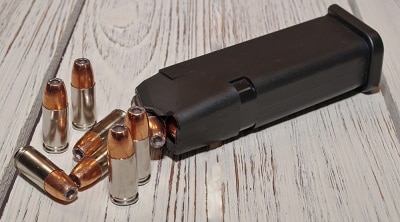For many firearms users, this question can be a little confusing. Grain isn’t exactly commonly used anymore. So, in this article, we will clear up some of the confusion about what exactly a grain is, and then make some recommendations about what grain is best to shoot.
Continue reading to learn more about grains in ammo.
Recommended Read: How to Choose the Right Bullet Weight for Your Weapon!
Grain – The Basics
A grain is a unit of measurement for mass. It is an extremely small unit. In fact, 1 ounce is equal to 437.5 grains, just to give you an idea of how small it is.
For another comparison, 1 gram is equal to 15.43 grains. Since 1 gram is approximately a paper clip, I’m sure this gives you an idea of how small a grain is.
Many people think that grain refers to something with the gunpowder or propellant used. However, it really has nothing to do with that. In ammunition, grains are used to say how large the projectile of the cartridge is.
So, when ammunition says it is 55 grain FMJ, it means that the actual bullet that will fly downrange weighs 55 grains.
Recommended Read: What’s the Best Conceal Carry Gun? Top 10 Revealed
Choosing the Right Grain
Now that you know exactly what a grain is, and what it refers to in ammunition, let’s talk a little about how to choose which bullet size you will shoot.
Each caliber of ammunition generally has quite a few different choices for grain size. This number is only increased if you are handloading your own ammunition.
Before making a decision, it’s important to know about all of the options available in the caliber you are thinking about.
When you’re trying to decide the size of the ammunition, there’s a couple things to keep in mind. First of all, what exactly are you shooting for?
If you’re hunting, you want a different round than if you are just shooting at the range.
Recommended Read: 4 Things You Need to Know When Buying a Used Gun
Hunting/Defense
For hunting and any kind of defense shooting, a larger grain is generally better. Larger grain, heavier bullets, generally perform better inside a target. However, there’s a lot more to consider.
For example, jacketed hollow point ammunition performs extremely well inside of a live target, while full metal jacket ammunition will not do as well.
If the choice is between heavier full metal jacket and lighter jacketed hollow point, I would go with jacketed hollow point every time. It expands on impact, and damages more tissue.
However, if there are multiple grains of jacketed hollow point ammunition, heavier is generally a little better. Just to caveat that, it’s not a set in stone rule. Your best bet is to try and find some ballistics testing or gelatin testing that others have done to see which performs better.
Precision Shooting

If you’re doing any type of competition or long range accuracy shooting, the exact projectiles can play a huge factor in the accuracy of the weapon. Most people choose match grade ammunition, but there are a couple things to keep in mind.
First, the shape of the bullet plays equally as important of a role. Aerodynamics are extremely important, especially over distance.
Next, there are some weapons that just don’t shoot some ammunition well. For whatever reason, some weapons seem to prefer some types of ammunition. The only way that you’ll know this is by testing and shooting multiple types of ammo.
Range Shooting
If you are just plinking at the range, your bullet weight really doesn’t matter. If you’re going to be using the weapon for anything other than range shooting at other points in time, we recommend putting some of your actual choice of ammunition through the weapon, just to make sure it handles the ammunition well.
Conclusion
Now that you understand what grain means in ammunition, you will hopefully be able to make some better choices with what ammunition you are shooting. Unfortunately, there isn’t one exact answer since most calibers have so many different choices, but we have given you some recommendations to consider.
Essentially, just make sure you test out different kinds of ammo, and see which one offers the best performance for your use for your weapon.

Just plinking at the range and weight doesn’t matter? Got to disagree, in some instances. If you’re just plinking to keep the rust off your finger and you’re at some longer distances…weight can have a big affect on the trajectory of your projectile. Lighter bullet means flatter trajectory and can put you off target.
great points altogether, you just won a new reader.
What would you recommend in regards to your submit that you
just made a few days ago? Any positive?
I just have a question. I am a new gun owner. I have a Smith and Wesson 380 EZ M&P handgun. I have been using 95 grain ammo in it. My son bought me 2 boxes of 50 grain. What is the difference?
My dad is currently looking for a one-fire brass that he may use for his Ammo gun. Anyhow, it’s a good thing that you shared this; at least now we’re aware that we must investigate further the various types of caliber. Thank you for sharing here as well the importance of testing the bullets first.